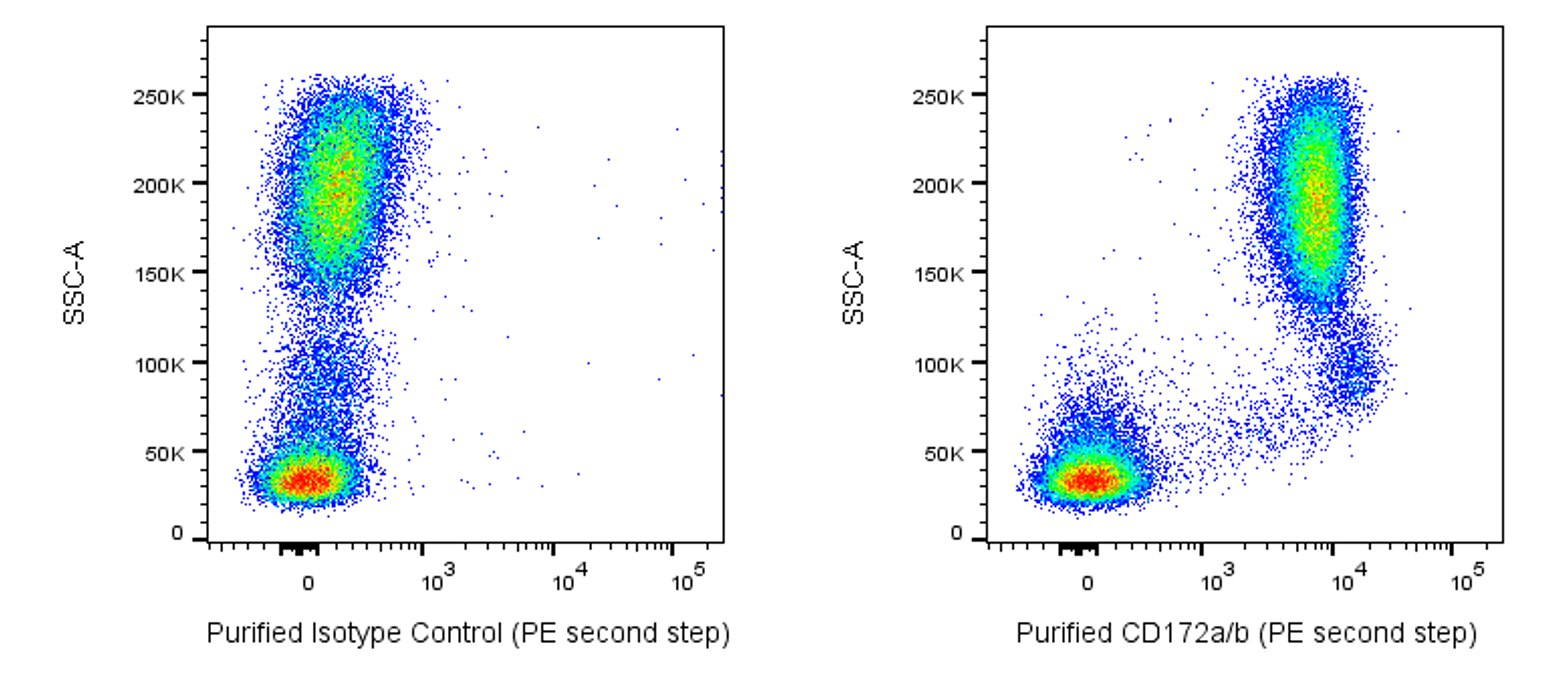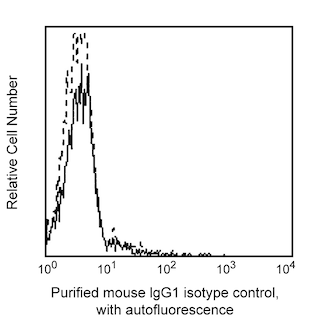Old Browser
Looks like you're visiting us from {countryName}.
Would you like to stay on the current country site or be switched to your country?




Multicolor flow cytometric analysis of CD172a/b expression on human peripheral blood leucocyte populations. Human whole blood was stained with either Purified Mouse IgG1 κ Isotype Control (Cat. No. 554121; Left Plot) or Purified Mouse Anti-Human CD172a/b antibody (Cat. No. 567875; Right Plot) at 0.015 µg/test, followed by PE Goat Anti-Mouse Ig (Multiple Adsorption) (Cat. No. 550589). Erythrocytes were lysed with BD Pharm Lyse™ Lysing Buffer (Cat. No. 555899). Bivariate pseudocolor density plots showing CD172a/b expression (or Ig Isotype staining) versus side light-scatter (SSC-A) signals were derived from gated events with the forward and side light-scatter characteristics of intact human leucocytes. Flow cytometry and data analysis were performed using a BD LSRFortessa™ Cell Analyzer System and FlowJo™ software. Data shown on this Technical Data Sheet are not lot specific.


BD Pharmingen™ Purified Mouse Anti-Human CD172a/b

Regulatory Status Legend
Any use of products other than the permitted use without the express written authorization of Becton, Dickinson and Company is strictly prohibited.
Preparation And Storage
Product Notices
- Since applications vary, each investigator should titrate the reagent to obtain optimal results.
- An isotype control should be used at the same concentration as the antibody of interest.
- Caution: Sodium azide yields highly toxic hydrazoic acid under acidic conditions. Dilute azide compounds in running water before discarding to avoid accumulation of potentially explosive deposits in plumbing.
- Please refer to www.bdbiosciences.com/us/s/resources for technical protocols.
- Sodium azide is a reversible inhibitor of oxidative metabolism; therefore, antibody preparations containing this preservative agent must not be used in cell cultures nor injected into animals. Sodium azide may be removed by washing stained cells or plate-bound antibody or dialyzing soluble antibody in sodium azide-free buffer. Since endotoxin may also affect the results of functional studies, we recommend the NA/LE (No Azide/Low Endotoxin) antibody format, if available, for in vitro and in vivo use.
- Please refer to http://regdocs.bd.com to access safety data sheets (SDS).
Companion Products



.png?imwidth=320)

The SE5A5 monoclonal antibody specifically binds to a common epitope on CD172a/SIRPα (90 kDa) and CD172b/SIRPβ1 (50 kDa). These transmembrane glycoproteins are members of the Signal Regulatory Protein (SIRP) family that, in turn, belongs to the Immunoglobulin superfamily. The SIRP family is comprised of two subgroups, SIRPα and SIRPβ that are distinguished by the presence (α) or absence (β) of a cytoplasmic domain containing two immunoreceptor tyrosine-based inhibition motifs (ITIM). CD172a/SIRPα is expressed on CD34+ stem/progenitor cells, cardiomyocytes, monocytes, macrophages, granulocytes, dendritic cells, and in the central nervous system. It binds to CD47 and is implicated in mediating inhibitory signals via the ITIM/SHP-2 association. CD172b/SIRPβ1 does not possess a cytoplasmic domain but instead the transmembrane domain contains a positively-charged residue that can interact with another transmembrane protein, DAP-12/KARAP. DAP-12 has two immunoreceptor tyrosine-based activation motifs (ITAM) within its cytoplasmic domain that are thought to link CD172b to cellular activation signaling. CD172b is expressed on myeloid cells, including peripheral blood monocytes and granulocytes. It is not expressed on CD34+ cells. CD172a and CD172b have complementary roles in signal regulation and may work together in tuning certain cellular responses to stimuli.
Development References (7)
-
Bühring HJ, Simmons DL, Vernon-Wilson E. Review—CD172—SIRP; signal regulatory protein. In: Mason D. David Mason .. et al., ed. Leucocyte typing VII : white cell differentiation antigens : proceedings of the Seventh International Workshop and Conference held in Harrogate, United Kingdom. Oxford: Oxford University Press; 2002:35.
-
Dietrich J, Cella M, Seiffert M, Bühring HJ, Colonna M. Cutting edge: signal-regulatory protein beta 1 is a DAP12-associated activating receptor expressed in myeloid cells. J Immunol. 2000; 164(1):9-12. (Biology). View Reference
-
Dubois NC, Craft AM, Sharma P, et al. SIRPA is a specific cell-surface marker for isolating cardiomyocytes derived from human pluripotent stem cells. Nat Biotechnol. 2011; 29:1011-1018. (Biology). View Reference
-
Ghannadan M, Hauswirth AW, Schernthaner GH, et al. Detection of novel CD antigens on the surface of human mast cells and basophils. Int Arch Allergy Immunol. 2002; 127(4):299-307. (Biology). View Reference
-
Seiffert M, Brossart P, Cant C, et al. Signal-regulatory protein alpha (SIRPalpha) but not SIRPbeta is involved in T-cell activation, binds to CD47 with high affinity, and is expressed on immature CD34(+)CD38(-) hematopoietic cells.. Blood. 2001; 97(9):2741-9. (Clone-specific: Immunoprecipitation, Inhibition). View Reference
-
Seiffert M, Cant C, Chen Z, et al. Human signal-regulatory protein is expressed on normal, but not on subsets of leukemic myeloid cells and mediates cellular adhesion involving its counterreceptor CD47. Blood. 1999; 94(11):3633-3643. (Immunogen: Flow cytometry, Functional assay, Immunoprecipitation, Inhibition). View Reference
-
Simmons DL, Vernon-Wilson E. Structure and function of the signal regulatory proteins (SIRPs). In: Mason D. David Mason .. et al., ed. Leucocyte typing VII : white cell differentiation antigens : proceedings of the Seventh International Workshop and Conference held in Harrogate, United Kingdom. Oxford: Oxford University Press; 2002:35-38.
Please refer to Support Documents for Quality Certificates
Global - Refer to manufacturer's instructions for use and related User Manuals and Technical data sheets before using this products as described
Comparisons, where applicable, are made against older BD Technology, manual methods or are general performance claims. Comparisons are not made against non-BD technologies, unless otherwise noted.
For Research Use Only. Not for use in diagnostic or therapeutic procedures.
Refer to manufacturer's instructions for use and related User Manuals and Technical Data Sheets before using this product as described.
Comparisons, where applicable, are made against older BD technology, manual methods or are general performance claims. Comparisons are not made against non-BD technologies, unless otherwise noted.
Report a Site Issue
This form is intended to help us improve our website experience. For other support, please visit our Contact Us page.